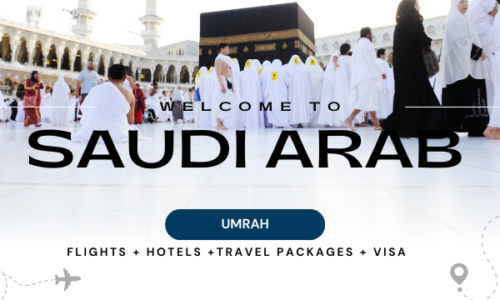Umrah Programs & Offers
Umrah Programs with other Destinations
Featured Hotels

Umrah with ZED International
Plan, Book and Embark on your Umrah Journey !
ZED International Umrah Programs
Who We Are?
What We Offer?
About Saudi Arab
We’re truely dedicated to make your Umrah travel experience is as smooth as it can be!
Bringing you a modern, comfortable, and connected travel experience is one of our highest priorities and that’s
why we continuously try to improve your experience when you book anything with us.
We really appreciate and welcome any of suggestions you might have for us, so we are open for your feedbacks and suggestions.
Umrah & Ziyara
All you need to know about Rituals to perform in Umrah and Ziyarah Al Masjid An Nabawi
What is the Umrah?
Umrah is an act of worshipping ALLAH by entering the state of Ihram, circumambulating the House, running between Safa and Marwa, and having the head shaved or trimmed.
How do I enter into the state of Ihram?
- A Muslim enters into the state of Ihram at the place specified by Sharia, and shall abstain from the Ihram prohibitions;
- He shall recite Talbiyah, saying: “Labbayka Allaahumma Labbayk, Labbayka La Shareeka Laka Labbayk. Innal Hamda Wan-ni’mata Laka Wal-Mulk, La Shareeka Lak” (Here I am at your service, o Allah, at Your service! At Your service! You have no partner! I am at Your service! Indeed, all praise and grace belong to You, and so does the supreme authority. You have no partner)
Circumambulation (Tawaf):
- He/she goes to the Haram
- When the Kaaba is to the left, they circumambulate (counterclockwise)
- He begins and ends at the Black Stone
- After completion of the seven rounds, you pray two Rakaah in an appropriate place.
Sa’i (between Safa and Marwa):
He/she heads to Safa where he starts Sa’i towards Marwa. Once reaching Marwa, you have completed one round. Crossing the distance back to Safa fulfills the second round, and so on until the seventh round ends at Marwa.
Having hair of the head shaven or trimmed:
- After completing Sa’i, men go to the barber shops to have their hair shaven or trimmed
- Women gather their hair and cut from its ends about (1-2 cm)
- With this act, the Umrah would be completed, marking the end of Ihram
Performing more than one Umrah during the same trip
- Performing the Umrah is one of the best and greatest deeds in the sight of Allah, as the Prophet (blessings and peace be upon him) said: “The performance of one Umrah is an expiation for what was committed between it and the previous. And it is allowed to repeat more than once per year”.
Best time to perform Umrah
A Muslim may perform Umrah at any time. However, there are important criteria for determining the appropriate time for Umrah for each person:
- It is better for the pilgrim to choose the less crowded times so that they can perform the rituals of Umrah, go near the Haram, and pray there with ease.
- There is a special merit for Umrah in the month of Ramadan. The Prophet’s blessings and peace be upon him said: “Performance of Umrah during Ramadan is equal to Hajj”, or he said: “Equal to the performance of Hajj with me”.
- Pilgrims must perform Umrah at the time allotted to them, according to their reservations on the official Umrah apps.
- Umrah is not allowed during the Hajj season, for those who do not intend to combine it with Hajj, to keep the Sacred sites available for pilgrims, because they are more deserving of those sites than others at that time.
Umrah pilgrims should avoid any conduct that harms others in the Haram, such as jostling, entering crowded places, and reversing the direction of circumambulation. They shall carefully follow the instructions of observers and security personnel.
Is it possible to move between the cities of the Kingdom with the Umrah Visa?
Yes, the Umrah visa allows the Mu’tamir to move between the Makkah-al-Mukarramah, Madina, and all the cities of the Kinddom during the period of permited stay.
Are there specific Airports for the entry and departure of Mu'tamirs?
A Mu’tamir can enter and depart from any international or regional airport in the kingdom of Saudi Arabia.
Travelling by Air
From King Abdulaziz International Airport in Makkah
The airport gives arrivals quick access to Makkah via the Haram Train Station adjacent to the arrivals hall. They can also have access to the Bus Service going straight to the Grand Mosque. You can also take a taxi or a private transfer and head to Makkah via Prince Mohammad Bin Salman Road, Huda Al-Sham Road, or the old Makkah-Jeddah Road, stop at one of the entrances to Makkah, and move from it to the Grand Mosque via Mosque Buses.
Travelling by Air
From Prince Mohammad Bin Abdulaziz International Airport in Makkah
Travelling by Air
From Taif International Airport
Travelling by Road
From Jeddah City
Passengers can travel from Jeddah to Makkah via the Harmain Train Stations at King Abdulaziz Airport or Sulaymania Train Stations. From there they may proceed to Makkah Station in Al-Rusaifah District, and then to the Grand Mosque via Makkah buses. Travellers from Jeddah to Makkah can take public transport buses from the corniche center area; they can also go by taxi from Al-Sham Road, or the old Makkah-Jeddah Road. You can book a ride via Green Taxi , Careem or Uber.
Travelling by Road
From Madina City
Passengers from Madinah can reach Makkah via the Al Harmain Train Station on King Abdulaziz Street.
Travelling by Road
From Taif City
Passengers from
Pilgrims from all over the world travel to Makkah for Hajj and ‘Umrah in huge numbers, amounting to millions of visitors annually. For this reason, exceptional efforts are made to provide services for pilgrims and visitors. Thus, they can devote themselves to performing their acts of worship in a safe and secure environment freely. Here are some of the services provided in the Grand Mosque.
Friday sermon translation service: A translation of the Grand Mosque Friday sermon can be listened to in several languages through the Manarat Al-Haramain Digital Platform, which provides an audio-translation of the sermon live Urdu, French, Malay, Persian and English.
Answering the queries of worshippers: Telephones dedicated to answering the questions and inquiries of pilgrims and worshippers are placed throughout the Grand Mosque. This service is available in seven world languages.
Meanings of the Qur’an in several languages: Translation of the meanings of the Qur’an is available in many world languages for guests to read the Qur’an and contemplate its meanings while they are in the Haram. These translations are found on the Qur’an bookshelves. You can also ask for them. These translations are an endowment for the Haram and cannot be taken outside.
Services for people with disabilities:
Here are some of the most important services provided to people with special needs in the Grand Mosque:
- Translation of the Friday sermon is available in sign language for people with hearing impediments. The service is provided in the prayer hall in King Fahd Extension, Gate 64.
- For people with special needs, there are:
- An area in King Fahd Extension accommodating more than 25 persons
- Prayer area in the circumambulation yard, known as the Tawaaf Prayer Area,
- The Ajyad Prayer Hall on the first floor,
- The prayer hall located in King Fahd Extension on the ground floor in front of Gate 67.
- The women’s prayer halls next to Gate 88 and Gate 74 on the ground floor.
- Providing electronic Qur’an devices and Qur’ans in Braille for the blind.
- Elevators are available to carry wheelchairs to the upper floors and to toilets.
Wheelchair service: There are large numbers of electric and manual wheelchairs available in the Grand Mosque. The baggy car service is available free of charge to transport pilgrims, elderly worshipers and people with special needs in the courtyards of the Grand Mosque. There are more than 5,000 regular wheelchairs and nearly 3,000 electric wheelchairs to facilitate the movement of pilgrims with disabilities.
Zamzam water is one of Allah’s blessings on Makkah and its visitors. Allah bestowed it on Isma’il, peace be upon him, and his mother Hagar, when Abrahim, peace be upon him, left them in Makkah in response to Allah’s command to him. Then, he supplicated to his Lord, saying: ”Our Lord! verity I have settled some of my posterity in an uncultivable valley near unto Your Sacred House. Our Lord! that they may establish the prayer; so incline some hearts of men that they may yearn toward them, and provide them with fruits in order that they may be thankful.”
Therefore, Allah caused that sweet water to spring from under the feet of the child, and granted it characteristics and advantages incomparable to any water on earth, to honor Abrahim, his son, and his wife, and after them the nation of Muhammad (blessings and peace be upon him).
Zamzam water in the two Grand Mosques:
-
Zamzam water is supplied in drinking water containers throughout the Grand Mosque of Makkah and the Prophet’s Mosque, in two conditions: cooled, which is usually offered, and uncooled, which is marked.
-
Plastic cups are available for drinking. These are single-use cups. New cups are stacked on the right-hand side of each container and shall be disposed of in the bin on the left-hand side.
-
The water staff periodically refill the containers, so moving these containers from their place will disrupt refilling work.
-
These containers are prepared for drinking only. Using them for ablution or taking water outside the Haram wastes Zamzam water and exposes visitors and pilgrims to slipping and pollution.
As part of the system of spatial directions in the Grand Mosque, its corridors and courtyards, a large number of guide signs written in world languages guide visitors of the Grand Mosque, so that they can move and reach places easily.
There are several types of guide signs in the Haram:
- Portable guide signs: These signs can be easily moved according to Grand Mosque entry and exit plans. They can be seen from a long distance because they are equipped with a height control feature.
- Area signs in Masa’a, second Saudi expansion, Mataf (circumambulation area), ablution facilities and water closets. They are designed in beautiful shapes, sizes and colors that are symmetrical with the architectural design of the Grand Mosque, taking into account the visibility of writing and signs. They include: signs to be followed after completing circumambulation, which indicate the direction of Masa’a and Al-Safa, where Sa’i starts.
- Electronic guide signs (high-resolution screens) are used to disseminate directional and guidance content, direct pilgrims to their sites, explain precautionary measures and ensure the safety of visitors of the Grand Mosque.
- Grand Mosque Gate Panels: These are the panels on which the name of the respective gate is displayed. QR codes have been added to show the basic information on each gate and its name. There are also guide signs that display whether a gate is entry-only or exit-only to visitors at a distance.
All these services have been introduced to serve Hajj and ‘Umrah pilgrims as well as worshipers. By following them, each person will access places easily, save time and effort, and contribute to the smooth flow of movement throughout the Haram.
The Haram Mosque and its holy site services have been developed and expanded in conformity with highest standards. It has become an example in service quality and construction grandeur. A pilgrim usually needs to use the escalators to go up or down in the Sanctuary and its squares to access services, so here are the most important warnings for when using the escalators:
- Do not sit on the escalator even if you are tired. Stand firmly on the escalator and hold the handrail.
- Women should be careful that their hijabs and loose clothes do not get stuck at the end of the escalator.
- Walk immediately after the escalator reaches the end so that people do not collide with you from behind.
- Do not place wheelchairs onto the escalator unless you do so with the help of a competent person.
- If you have an elderly person or a person who is not accustomed to taking the escalator, be by his side and hold him to protect him from falling.
- Do not push people or annoy your fellow pilgrims if there is crowding when going up or down, and give your brothers an opportunity to get on.
- Do not place your foot on the side brush at the bottom of the escalator as this may injure you and disrupt the cleaning system of the escalator.
- Go to the nearest hospital if you experience any nosebleed, headache or cramps.
Restaurants & Cafes

Dar Kurkum
If you are a fan of Indian food, Dar Kurkum Restaurant is the best Indian restaurant in Makkah, the design of the restaurant is wonderful, it is beautifully decorated and has a special place for families and singles, the ambiance is very nice, nice and comfort

Al Tandoor
Al Tandoor Restaurant is considered one of the most important Indian restaurants in Makkah because of its delicious dishes, recipes, and the best taste of its Indian food.

Al Bait
A sumptuous array of international flavours. located on the 11th floor of Al Marwa Rayhaan by Rotana. Open for breakfast, lunch and dinner.
Places to visit in Makkah Al Mukaramah

GHAR HIRA (HIRA CAVE
Taking 1,200 walking steps to reach, the cave itself is about 3.7 m in length and 1.6m in width. The cave is situated at a height of 270 m of Jabal Al Nour Mountain. During Hajj season an estimated of ve thousand pilgrims climb to the Cave of Hira daily to see the place where Prophet Muhammad (PBUH) received the rest revelation of Quran.

MAKKAH MUSEUM
Highlights the cultural and historical dimensions of Makkah Al Mukaramah region, and to inform and educate the community. It offers details between the civilizations and the history of Makkah Al Mukaramah since the dawn of history until the prosperous present. This Museum was established in Al-Zahir Palace.Museum was established in Al-Zahir Palace.

ABRAJ AL BAIT
Also known as, Fairmont Makkah Clock Royal Tower, it is a ver-star hotel located next to the Masjid Al Haram, closest hotel to The Holy Kaaba and the best for Umrah and Hajj. It is one of the world’s tallest buildings with 120 floors and 1542 guest rooms suites and Residences, 9 state-of-the-art restaurants, 56 elevators that allow easy access to and from Al Masjid Al Haram.

KISWA FACTORY
Kiswa factory is where visitors can get to see the Kiswa of The Holy Kaaba being made right in front of them. The factory has been making the kiswa of The Holy Kaaba since 1927 AD and has gone through many upgrades and renovation works over the years. To visit the factory you will need a permit beforehand.

MINA
Also known as the Tent City. It is situated 5 kilometres to the east of Makkah Al Mukarama. It covers an area of approximately 20 km . Mina is best known for the role it plays during the Hajj. More than 100,000 air-conditioned tents that can house more than 3 million people provide temporary accommodation to visiting pilgrims.

MUZDALIFAH
Is an open area near Makkah Al Mukaramah associated with the Hajj. It is located between Mina and Arafat. And the pilgrims spend the night in it after their departure from Arafat, then they perform the Maghrib and Isha prayers on Friday and collect pebbles in it to throw stones at Mina, and the pilgrims stay in it until the next morning on the day of Eid al-Adha, and then they leave to Mina.

RAMI AL-JAMARAT
Rami al-Jamarat Stoning of the Devil is part of the Hajj pilgrimage to the holy city of Makkah Al Mukaramah. During the ritual, Muslim pilgrims throw pebbles at three walls (formerly pillars), called Jamarat, the first of which is the Jamrat Al-Aqabah, the pilgrim throws it in the Ihram clothing on the Day of Sacrifice, and the three days of Al-Tashreeq, when the pilgrim throws them after the first exhumation of Ihram.
Places to visit in Al Madinah Al Munawwarah

HEJAZ RAILWAY MUSEUM
This museum showcases one of the oldest railways in old Hejaz that used to connect Damascus and Al Madinah Al Munawwarah passing through Jordan, Sahari, Tabouk mountains and Hejaz mountains. It is 1,329 km long and was established by Sultan Abed Al Hameed the second in 1900. Now open to public as a museum, it displays the history of the station and Al Madinah Al Munawwarah.

KING FAHD COMPLEX FOR THE PRINTING OF THE HOLY QURAN
Is the largest printing plant located in Al Madinah Al Munawwarah, Saudi Arabia that publishes the Qur’an in Arabic and other languages. The company produces about 10 million copies a year since 1985, and made over 10 million books of the Qur’an that has been distributed all around the world.

QUBA MOSQUE
The oldest mosque in the world that dates to the lifetime of the Islamic prophet Muhammad. its first stones were positioned by Muhammad as soon as he arrived on his emigration from the city of Mecca to Al Madinah Al Munawwarah. The mosque is well known with its unique Islamic design and high minarets and a fascinating interior















